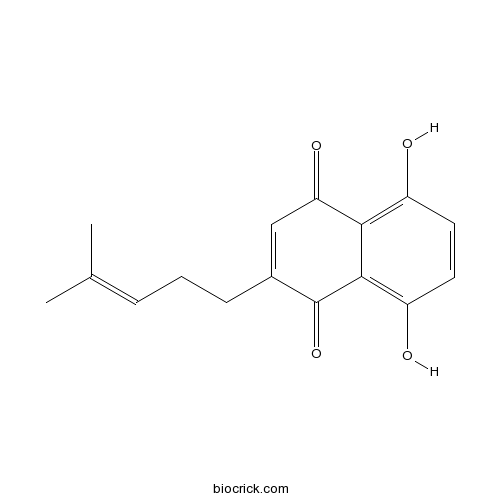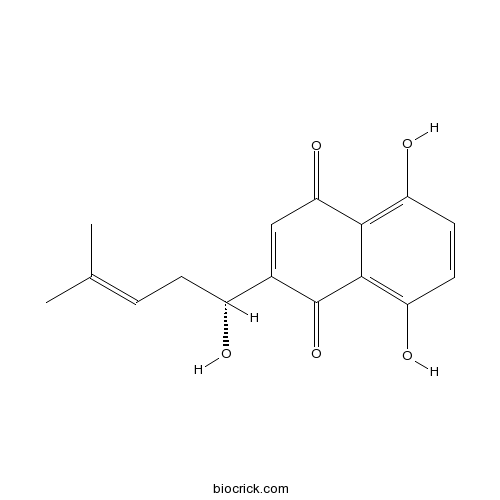Lithospermum erythrorhizon
Lithospermum erythrorhizon
1. The products in our compound library are selected from thousands of unique natural products; 2. It has the characteristics of diverse structure, diverse sources and wide coverage of activities; 3. Provide information on the activity of products from major journals, patents and research reports around the world, providing theoretical direction and research basis for further research and screening; 4. Free combination according to the type, source, target and disease of natural product; 5. The compound powder is placed in a covered tube and then discharged into a 10 x 10 cryostat; 6. Transport in ice pack or dry ice pack. Please store it at -20 °C as soon as possible after receiving the product, and use it as soon as possible after opening.
Natural products/compounds from Lithospermum erythrorhizon
- Cat.No. Product Name CAS Number COA
-
BCN8862
Isoarnebin I24502-79-2
Instructions

-
BCN3006
Deoxyshikonin43043-74-9
Instructions

-
BCN3530
Shikonine517-89-5
Instructions

Autophagy is involved in acetylshikonin ameliorating non-alcoholic steatohepatitis through AMPK/mTOR pathway.[Pubmed: 30055803]
Acetylshikonin (AS), a naphthoquinone constituent derived from Lithospermum erythrorhizon, has been revealed various pharmacological activities including anti-oxidative, anti-inflammatory and antifertility effects. Our previous study has illuminated the effects of AS on preventing obesity and hepatic steatosis in db/db mice. However, the effects of AS and the molecular mechanisms for curing non-alcoholic steatohepatitis (NASH) have not yet been studied. Autophagy has been considered as a lysosomal degradative pathway responsible for the removal of cellular lipid droplets through a process called lipophagy, which is recognized as a potential therapeutic approach for NASH. Here we hypothesize that autophagy is involved in the beneficial effects of AS on methionine-choline deficient (MCD) diet-induced NASH of mice. In this study, we observed that AS treatment ameliorated the pathological signs of NASH, and markedly suppressed the levels of hepatic IL-1β and TNF-α cytokines, and hepatocyte apoptotic cells in MCD diet-induced mice. Moreover, immunological analyses showed that the elevated expression of the fibrotic markers including α-SMA, collegen I, collegen III and fibronectin in MCD diet-induced mice were notably down-regulated by AS treatment. Nevertheless, the beneficial effects of AS on ameliorating NASH were notably counteracted by co-administration of chloroquine, an autophagy inhibitor. Furthermore, our data suggested that AS treatment increased hepatocyte autophagy in MCD diet-induced mice via AMPK/mTOR pathway. These findings suggest that AS could be therapeutically effective in the development of NASH by ameliorating steatosis, inflammation, liver injury and fibrosis.
Gromwell (Lithospermum erythrorhizon) root extract protects against glycation and related inflammatory and oxidative stress while offering UV absorption capability.[Pubmed: 29906314]
Glycation and advanced glycation end products (AGE) damage skin which is compounded by AGE-induced oxidative stress and inflammation. Lip and facial skin could be susceptible to glycation damage as they are chronically stressed. As Gromwell (Lithospermum erythrorhizon) root (GR) has an extensive traditional medicine history that includes providing multiple skin benefits, our objective was to determine whether GR extract and its base naphthoquinone, shikonin, might protect skin by inhibiting glycation, increasing oxidative defenses, suppressing inflammatory responses and offering ultraviolet (UV) absorptive potential in lip and facial cosmetic matrices. We show GR extract and shikonin dose-dependently inhibited glycation and enhanced oxidative defenses through nuclear factor erythroid 2-related factor 2 (Nrf2)/antioxidant response element activation. Inflammatory targets, nuclear factor kappa-light-chain-enhancer of activated B cells (NFκB) and tumor necrosis factor alpha, were suppressed by GR extract and shikonin. Glyoxalase 1 (GLO1) and glutathione synthesis genes were significantly upregulated by GR extract and shikonin. GR extract boosted higher wavelength UV absorption in select cosmetic matrices. Rationale for the use of GR extract and shikonin are supported by our research. By inhibiting glycation, modulating oxidative stress, suppressing inflammation and UV-absorptive properties, GR extract and shikonin potentially offer multiple skin benefits.
Alleviation of hepatic fibrosis and autophagy via inhibition of transforming growth factor-β1/Smads pathway through shikonin.[Pubmed: 29864192]
Liver fibrosis is a worldwide clinical challenge during the progression of chronic liver disease to liver cirrhosis. Shikonin is extracted from the root of Lithospermum erythrorhizon with antioxidant, anti-inflammatory, anticancer, and wound-healing properties. The study aims to investigate the protective effect of shikonin on liver fibrosis and its underlying mechanism.
Shikonin enhances sensitization of gefitinib against wild-type EGFR non-small cell lung cancer via inhibition PKM2/stat3/cyclinD1 signal pathway.[Pubmed: 29738778]
Mutant EGFR Non-small cell lung cancer has benefit from gefitinib, but it has limited effect for wild-type EGFR tumors. Shikonin, a natural naphthoquinone isolated from a traditional Chinese medicine, the plant Lithospermum erythrorhizon (zicao), not only can inhibit the tumor growth, but also overcome cancer drug resistance. Our aim is to investigate whether shikonin can enhance antitumor effect of gefitinib in EGFR wild-type lung cancer cells in vitro and in vivo.
Endoplasmic reticulum stress-mediated autophagy protects against β,β-dimethylacrylshikonin-induced apoptosis in lung adenocarcinoma cells.[Pubmed: 29676829]
β,β-Dimethylacrylshikonin (DMAS) is an anti-cancer compound extracted from the roots of Lithospermum erythrorhizon. The present study aims to investigate the effects of DMAS on human lung adenocarcinoma cells in vitro and explore the mechanisms of its anti-cancer action. We showed that DMAS markedly inhibited cell viability in a dose- and time-dependent way, and induced apoptosis as well as autophagy in human lung adenocarcinoma cells. Furthermore, we found that DMAS stimulated endoplasmic reticulum stress and mediated autophagy through the PERK-eIF2α-ATF4-CHOP and IRE1-TRAF2-JNK axes of the unfolded protein response in human lung adenocarcinoma cells. We also showed that the autophagy induced by DMAS played a prosurvival role in human lung adenocarcinoma cells and attenuated the apoptotic cascade. Collectively, combined treatment of DMAS and pharmacological autophagy inhibitors could offer an effective therapeutic strategy for lung adenocarcinoma treatment.
Beneficial effect of Burdock complex on asymptomatic Helicobacter pylori-infected subjects: A randomized, double-blind placebo-controlled clinical trial.[Pubmed: 29520881]
Burdock complex (BC) constitutes of burdock (Arctium lappa), angelica (Angelica sinensis), gromwell (Lithospermum erythrorhizon), and sesame (Sesamum indicum) oil, which are commonly used in traditional Chinese medicine (TCM) for treating various disorders. This study intended to examine the anti-H. pylori activity of BC on AGS cell model as well as in asymptomatic H. pylori-infected subjects.


